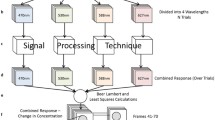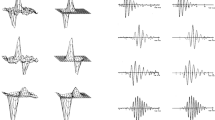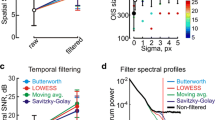Recording of the intrinsic optical signal (IOS) is widely used or functional studies of the cerebral cortex in vivo. Despite the fact that IOS provides for detection of active areas, regardless of the age of the object, it is widely used in studies of the developing brain. However, in immature brains IOS has low amplitude, which hinders its use and requires other recording and analysis methods. We report here our assessment of the use of the principal components analysis (PCA) method for the automatic detection of IOS at the early stages of development of the rat brain. Recording of IOS in infrared light and use of PCA was found to provide reliable detection of IOS in rats in the first three weeks after birth. Addition of artificial noise to IOS showed that detection using PCA was effective in half of cases despite increases in the noise level to four times baseline. These results provide evidence that the PCA method has potential to be used for detecting IOS at the early stages of development and that the PCA method is very robust for detection of IOS.
Similar content being viewed by others
References
A. Grinvald, R. D. Frostig, E. Lieke, and R. Hildesheim, “Optical imaging of neuronal activity,” Physiol. Rev., 4, No. 4, 1285–1366 (1988).
R. D. Frostig, E. E. Lieke, D. Y. Ts’o, and A. Grinvald, “Cortical functional architecture and local coupling between neuronal activity and the microcirculation revealed by in vivo high-resolution optical imaging of intrinsic signals,” Proc. Natl. Acad. Sci. USA, 87, No. 16, 6082–6086 (1990).
M. Sintsov, D. Suchkov, R. Khazipov, and M. Minlebaev, “Improved recordings of the optical intrinsic signals in the neonatal rat barrel cortex,” BioNanoScience (2016), doi: https://doi.org/10.1007/S12668.016.0359.
R. M. Everson, A. K. Prashanth, M. Gabbay, et al., “Representation of spatial frequency and orientation in the visual cortex,” Proc. Natl. Acad. Sci. USA, 95, No. 14, 8334–8338 (1998).
M. Gabbay, C. Brennan, E. Kaplan, and L. Sirovich, “A principal components-based method for the detection of neuronal activity maps: application to optical imaging,” Neuroimage, 11, No. 4, 313–325 (2000).
A. Hyvarinen and E. Oja, “Simple neuron models for independent components analysis,” Int. J. Neural Syst., 7, No. 6, 671–687 (1996).
R. Khazipov, D. Zaynutdinova, E. Ogievetsky, et al., “Atlas of the Postnatal Rat Brain in Stereotaxic Coordinates,” Front. Neuroanat., dx.doi.org./103389/fnana.2015.00161.2015.
O. Mitrukhina, D. Suchkov, R. Khazipov, and M. Minlebaev, “Imprecise whisker map in the neonatal rat barrel cortex,” Cereb. Cortex, doi: https://doi.org/10.1093/cercor/bhu169.2014.
C. H. Chen-Bee, D. B. Polley, B. Brett-Green, et al., “Visualizing and quantifying evoked cortical activity assessed with intrinsic signal imaging,” J. Neurosci. Meth., 97, No. 2, 157–173 (2000).
A. M. O’Farrell, D. E. Rex, A. Muthialu, et al., “Characterization of optical intrinsic signals and blood volume during cortical spreading depression,” Neuroreport, 11, No. 10, 2121–2125 (2000).
S. Nelson, L. Toth, B. Sheth, and M. Sur, “Orientation selectivity of cortical neurons during intracellular blockade in inhibition,” Science, 265, 774–777 (1994).
M. Minlebaev, M. Colonnese, T. Tsintsadze, et al., “Early gamma oscillations synchronize developing thalamus and cortex,” Science, 334, No. 6053, 226–229 (2011).
M. Stetter, I. Schiessl, T. Otto, et al., “Principal component analysis and blind separation of sources for optical imaging of intrinsic signals,” Neuroimage, 11, 482–490 (2000).
R. Everson, B. W. Knight, and L. Sirovich, “Separating spatially distributed response to stimulation from background. I. Optical imaging,” Biol. Cybern., 77, No. 6, 407–417 (1997).
Author information
Authors and Affiliations
Corresponding author
Additional information
Translated from Rossiiskii Fiziologicheskii Zhurnal imeni I. M. Sechenova, Vol. 103, No. 2, pp. 152–160, February, 2017.
Rights and permissions
About this article
Cite this article
Sintsov, M.Y., Suchkov, D.S. & Minlebaev, M.G. Detection of Intrinsic Optical Signals in the Somatosensory Cortex of Neonatal Rats by Principal Components Analysis. Neurosci Behav Physi 48, 551–556 (2018). https://doi.org/10.1007/s11055-018-0598-0
Received:
Published:
Issue Date:
DOI: https://doi.org/10.1007/s11055-018-0598-0




